21.12.2006
Mark Dvoretsky. Critical approach to the combination
3. Incorrect and arguable combinations
A combination must be correct. Otherwise, it becomes an attempt, error or even blunder. In other words it is senseless Emanuel Lasker said. Of course, one shouldn't accept this statement as a common truth. For example, when a chessplayer is in a difficult situation even an incorrect combination is sensible if it poses some problems to the opponent and raises the practical chances for a successful result. Rudolf Spielmann noticed that one should evaluate a sacrifice from the standpoint of its dangerousness but not of its rightness.
Sometimes it is quite difficult to evaluate the practical prospects of the forethought combination. We improve the evaluation of the position when we think of these problems, compare different opportunities and try to choose the optimum one. However, our combinative failures are not mostly connected with the erroneous assessment. Either we blunder something when calculating the combination or we don't notice a strong alternative that makes this combination unnecessary and nonsensical.
At first, I wanted to mix the erroneous combinations with the correct ones from the previous part of the article because the very title of this part will serve as a hint for those who would like to use the following examples as exercises. However, sometimes it is sensible to get to know the subject of the training beforehand in order to concentrate on acquiring some habits. On this occasion we will train the ability of attentive examination of tempted tactical opportunities because it is very important not to lose sight of other resources. I recommend you not to refuse the combination at once (only if you see a simpler and stronger way for the victory). Better is to find its' underbelly and to compare the combination with the consequences of other continuations.
Simagin– Beilin
Vilnius 1946

White?
Vladimir Simagin was tempted with the alluring tactical idea.
1.¤e5-g6? f7:g6
2.¦e1:e6 Јe7-f7
3.¤c5:b7 ¤f6-d5!
It is obvious that White overlooked this move. Now he has to waste the tempo for repelling the threat of 4...Ј:f2+ and then Black will be able to take the knight.
4.¦e1-e2 Јf7:b7
5.¦c1-c5 ¦a8-d8
6.¦e1-e5 Јb7-f7!°
It is the second time when Black exploits the weakness of the f2 square. However, Black also wins by 6...¦f5.
Everything is clear. It was not necessary to go for the combination as it can be repelled in a forced way. White doesn't have the advantage in the initial position. The question is whether to choose 1.¤:b7!? (I would have preferred this move) or to save the c5 knight but to let the opponent's bishop occupy the important d5 square.
Bitman – Alekseev
Moscow 1969

White?
Everything is also clear in this position. There is no need to go for a combination because Black has a simple move 1...Ґf4! that wins the game immediately. White's queen is under attack and Black threatens with the checkmate on h5.
It is obvious that Black paid attention to the other continuation 1...Ґd7. Right now it is impossible because of the check on f7. At that moment Black thought of the sacrifice of the queen on c4. The point is that IM Alekseev couldn't resist the temptation.
1. . . . Јc5:c4?!
The game ended in a couple of moves: 2.ў:g4? Јe6+ 3.ўh4 h6 and White resigned.
Obviously, the sacrifice of the queen shocked Alexander Bitman. Otherwise, hewouldhavecalculatedthisshortvariation. It was necessary to take the queen (White has no alternative continuation) and to look for the defense on the next move as White has a wider choice there.
2.b3:c4 Ґc6-d7!
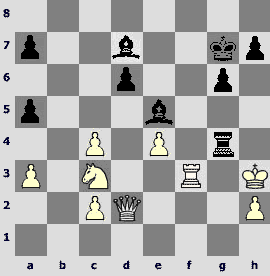
White?
When Aagaard showed me this study, he noticed that even some strong chessplayers hadn't managed to save the game. However, I coped with the task easily. Probably, I did it because of the habit of concentrating on looking for all sensible candidate moves.
Hopeless is 3.¦f5? gf. In case of 3.¤d5? Black wins playing either 3...¦g3+ 4.ўh4 ¦:f3 or 3...g5 4.¦f5 (4.¤f4 gf) 4...Ґ:f5 5.ef¦h4+ 6.ўg2 ¦:h2+. 3.Јf2? doesn't help White 3...¦g3+ 4.ўh4 g5+ 5.ўh5 Ґe8+ 6.¦f7+ Ґ:f7+ 7.Ј:f7+ ў:f7 8.hgҐ:c3°.
3.Јd2-e3!!
By moving his queen on the covered square, White not only defends it but also creates the threat of counter-attack 4.Ј:a7. This idea really binds the opponent's opportunities. For example 3...h6? 4.¦f5! gf 4.Ј:a7ќ.
Unsatisfactory is 3...g5? 4.¦f5ќ. After 3...¦:e4+ 4.ўg2 ¦:e3 5.¦:e3 the ending is unclear. In case of 3...Ґe6 White achieves a draw after both 4.¤d5 and 4.Ј:a7+ ўh6 5.¦f5! gf 6.Јe7 ¦g6 7.Јh4+ ўg7 8.Јe7+.
3. . . . ¦g4-g3+
4.ўh3-h4 ¦g3-g4+
Unfortunately, Black has nothing better. The fact is that neither 4...g5+? 5.Ј:g5+ ¦:g5 6.ў:g5 nor 4...¦g2? 5.h3! suitshim.
4.ўh4-h3=
Baiona – Aristizabal
Columbia 1993

Black?
It is clear that Black should give a check. However, there is an eternal problem of choice.
Useless is 1...¤e4+ 2.ўh1 and Black has to move his knight back to f2 (in case of 2...Јe3? 3.¦f1 Black can't defend himself against the threats 4.Ґc1 Јd4 5.¦f4 and 4.Ґa1, 5.Јb2).
In case of 1...¤d3+ 2.ўh1 Black has serious difficulties after 2...¤:b2? 3.Ј:b2±. Moreover, there is no sense in playing the sharpest position after 2...Јe3?! 3.¦f1 ¤c6 (3...¤:b2? 4.Ј:b2ќ) 4.h3!?.
The grandmasters Alexander Motylev, Vladimir Potkin and Ernesto Inarkiev found the most effective way to the victory.
1...¤g4+! 2.ўh1 Јd6 3.Ґ:e6+ (3.g3 Ґc6°) 3...Ґ:e6 4.g3 Јc6+ 5.Јg2 ¤f2+!? 6.ўg1 ¤h3+ 7.ўh1 and now Black plays either 7...Јb6° or 7...Ґ:c4° or 7...Ј:c4 8.¦d1 ¤c6° with the following 9...Ґf5.
The fact is that Black was tempted by the striking combination.
1. . . . ¤f2-d1+?!
2.ўg1-h1 Јc5:d5
3.¦a1:d1!
Black threatened with the checkmate on e1. However, now it seems that Black went wrong because in case of either 3...Јe4 or 3...Ј:g5 White continues 4.Јc3. If 3...Јd6 then 4.c5! (wrong is to choose either 4.h3? Јg3 or 4.Јc1? Ґ:a4! 5.¦:d6 ¦:d6) 4...Јd5 5.h3ќ.
3. . . . Ґd7:a4!!
4.Јc2:a4 Јd5-d2!
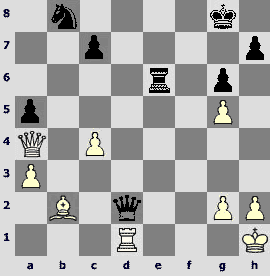
The threats 5...¦e1+ and 5...Ј:b2 seemed so convincing to White that he decided to resign immediately.
If White didn't have an alternative to the resignation Black's striking combination would really deserve approval. However, the capitulation was clearly premature.It is interesting to see how Black will demonstrate his advantage after 5.h3 Ј:b2 6.Ј:a5. In case of 6...Јb6?! 7.¦d8+ ўf7 8.Јd2! (with the threats 9.Јf4+ and 9.c5) White catches the initiative. Either after 6...¤c6 7.Ј:c7 or after 6...¦e7 7.Јc5! the game is unclear. In the variations 6...¤a6!? 7.Јb5!? Ј:b5 8.cb ¤c5 9.¦d8+ and 6...¦d6!? 7.Јe1!? (7.¦e1 Јf2µ; 7.¦:d6 Јc1+ 8.ўh2 Јf4+ 9.ўh1 Ј:d6 10.Јa8 c5 11.a4 ўf7µ) 7...¦:d1 8.Ј:d1 ўg7 9.a4 Black keeps the advantage but the way to the victory doesn't look rosy.
Shamkovich– Bisguier
USA 1978

White?
White had to repel the threat of 23...¤d4 by the simple 23.Ґ:b3 Ґ:b3 24.¦bc1. The game seems to be even.
A tempting tactical operation undertaken by Leonid Shamkovich could be refuted.
23.e4-e5?! d6:e5!
All other variations are totally bad: 23...¤d4? 24.Ґ:h7+! ў:h7 25.Јh5+ ўg8 26.ef; 23...¤:d2? 24.ef ¤:b1 25.Ґ:h7+!; 23...Ґ:e5? 24.Јd3.
24.Јe2-d3 e5-e4!
24...g6? 25.Ґ:b3 ¦fd8 26.Ґd5 Јd7 27.Ґa5!
25.Јd3:e4
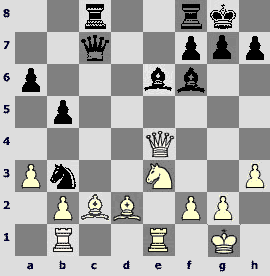
Black?
The game continued the following way: 25...g6? 26.Ґ:b3 Ґ:b3 27.¤g4! Ґg7 28.¦bc1 Јd8 29.¦:c8 Ј:c8 30.Ґb4 ¦d8 31.Јf3! Ґe6 32.¤f6+ ўh8 33.Ґc3! White threats with both ¦e4-h4 and Јe4-h4. White created the powerful attack and soon afterwards he gained the victory.
It is hard to explain why Arthur Bisguier missed an easy defense that definitely changes the assessment of the position. Perhaps, Nimzowitch was right: a chessplayer would rather stick his head into a lion's mouth than put his queen under attack.
25. . . . Јc7:c2!!
26.¤e3:c2 ¤b3:d2
27.Јe4-e2
Not better is 27.Јe3 ¤:b1 28.¤d4 ¦fe8! 29.¤:e6 ¦:e6 30.¦c1 ¤c3!°.
27. . . . ¤d2:b1
But not 27...¦:c2? because White wins back the piece playing 28.Јd3 ¦fc8 29.¦bd1.
28.¦e1:b1
28.¤b4 is more stubborn.
28. . . . Ґe6-f5
29.¦b1-c1 Ґf6:b2°
Belikov – Naftalin
correspondence 1988

White?
After his opponent's last move e7-e5 White is facing the dilemma.
The simple 19.¤d5 ¤:d5 20.cdkept a clear positional advantage. Black's bishops are a sorry sight. Especiallyitconcernsthewhite-squaredone.
However, the combination that begins with the blow on e5 seems to be really tempting. If this continuation is successful indeed it can provide White with a more benefit than a quiet variation. There is no need to refute it immediately. The point is that White really played so in the correspondence game.
19.Ґc3:e5?! d6:e5
20.Јd3:d8+ ¦b8:d8
White also has to reckon with 20...¤e8. There is nothing to calculate. It is necessary to evaluate the position. To my mind, after 21.Јh4 ef 22.Ј:f4 White's rook and two extra pawns are really stronger than the opponent's two pieces.
21.¦d1:d8+ Ґg7-f8
22.¤f4-d5!

Black?
Vladimir Belikov's idea came true in the game. The opponent became panic-stricken and lost a piece without any compensation. Black played 22...ўg7? 23.¤:f6 Ґc5 24.¤d5and resigned. It is hopeless to continue resisting after 24...Јc6 25.b4 or 24...a5 25.Ґh3 followed by 26.¦d7.
However, Black has two defensive opportunities. The point is that it is quite difficult to cast doubt on any of them. Perhaps, in this case the chessplayer has to turn down the combination especially as the alternative is rather attractive. Probably, it is possible to refute one of these defences. But then Black has the other one.
22. . . . ¤f6:d5!
A natural move. However, 22...¤g4!also deserves serious attention. On 23.Ґh3 Black replies 23...h5 and if 23.c5 (threatening with 24.c6) then 23...bc.
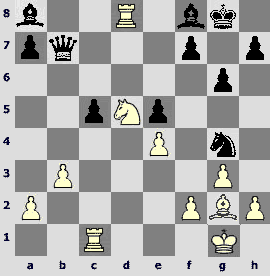
Now it is clear that 24.¦:c5? (threatening with 25.¦c7 and 25.¦cc8) doesn't work because of 24...Јa6! 25.¦:a8 (otherwise, 25...Ґ:d5) 25...Ј:a2 - an unexpected counter-attack. White can't defend square - f2. 26.¦c1 Ј:f2+ 27.ўh1 ўg7°.
If 24.h3 Black plays 24...¤:f2! 25.ў:f2 ўg7 and he is not worse. White's king is too weak.
At last, after 24.f3 ¤h6 25.¦:c5 ўg7the tempting 26.¦cc8? allows Black to obtain the advantage by the counter-attack 26...Јb5! 27.¦:f8 Ґ:d5 28.ed Ј:d5. Solid 26.¦c4 leads to the equal position only.
On the grounds of these variations it is useful to conclude that one should prefer defensive moves that contain the opportunity of the counter-actions. The active operations often turn out to be the most effective way of defense.
23.c4:d5 ўg8-g7
24.¦c1-c8 Ґf8-c5
The loss of the a8 bishop doesn't worry Black. He prepares the counter-attack against the f2 square (25.¦:a8 Јa6!). White has to trouble the opponent's king in order not to lose the initiative.
25.¦d8-g8+ ўg7-h6
Black loses after 25...ўf6? 26.¦c6+ ўg5 27.h4+ ўh6 28.g4 Ґe7 (Black has nothing better) 29.g5+ ўh5 30.¦g7 ў:h4 31.¦:f7.
26.h2-h4

Black?
White's idea consists in playing 27.¦c7! on 26...Јa6. He defends the f2 square from f7. But the fact is that the queen has another opportunity to become more active.
26. . . . Јb7-e7!
27.¦c8:a8 Јe7-f6
Black managed to reach the f2 square. Now he has the initiative indeed.
A.Sokolov – Utasi
Budapest 1983

White?
Thepositionisverycomplicated. The knight sacrifice on e6 is really striking. Before analyzing it, it is sensible to evaluate chances of both sides after more calm continuations.
It is necessary to reckon with 22...¤eg4. The following variation is rather demonstrative 22.fg fg (22...¤:g6?! 23.Јe1±) 23.¦ef2 ¤fg4 24.¦:f8+ ¦:f8 25.¦:f8+ ў:f8 26.Ґ:d8 Ј:d4 27.Јe7+ ўg8 28.h3 ¤f2+ 29.ўh2 with the probable draw. It seems that White doesn't stand worse but it is quite difficult to find the way of achieving the advantage.
22.¤d4-e6!? f7:e6
Black loses after 22...¤:d3? 23.¤:f8 (or 23.¤:d8) 23...¦:e2 24.¤:e2. Black has to accept the challenge.
23.f5:g6 ¤e5:g6
It is bad to continue 23...h6? 24.g7!ќ (Sokolov). The following variation leads to the difficult position: 23...¤eg4? 24.¦:f6 h6 (hopeless is 24...¤:f6 25.Ґ:f6 ¦:f6 26.Ј:h7+ ўf8 27.g7+) 25.¦f7 Ґ:g5 26.Ј:g4.
24.Ґd3:g6 h7:g6
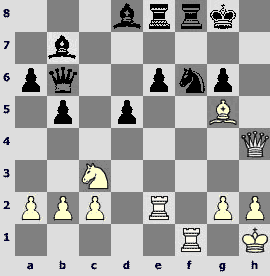
White?
It is the key point of the battle! What piece should take Black's knight? Let's begin with the "normal" move.
25.Ґ:f6 Ґ:f6 26.¦:f6 ўg7 27.¦:g6+!(there is no better move) 27...ў:g6 28.Јg3+ ўh7 and the game ends with perpetual check. However, the game is also drawn after 28...ўf7 29.¦f2+ ўe7 30.Јg7+ ўd8 31.¦:f8 Јe3=.
But the problem is that this analysis is incomplete. We didn't pay attention to the opponent's important tactical resource 26...e5!?. Now the game goes to the ending in a forced way: 27.¦:e5 Ј:f6 28.Ј:f6 ¦:f6 29.¦:e8+ ўf7 30.¦e1 ¦f2. However, White has to achieve a draw playing either 31.ўg1 ¦:c2 32.¦e2 ¦c1+ 33.ўf2 d4 34.¤e4 Ґ:e4 35.¦:e4 ¦c2+ 36.ўf3 ¦:b2 37.a4³ or 31.h4 ¦:c2 32.¦e2 ¦c1+ 33.ўh2 d4 34.¤e4³.
Andrei Sokolov strived for more and achieved his object because of the opponent's error.
25.¦f1:f6?!
The game ended in the following way: 25...Ґ:f6? 26.Ґ:f6 ¦:f6 27.Ј:f6 ¦f8 28.Ј:g6+ ўh8 29.Јh6+ ўg8 30.Јg6+ ўh8 31.Јh6+ ўg8 32.Јg5+ ўh8 33.h4!ќ¦f1+ 34.ўh2 Јc7+ (34...Јg1+ 35.ўg3) 35.¦e5! d4 36.¤e2 ¦f2 37.¤f4 ¦:c2 38.Јh6+. Black resigned.
As we analyzed the variation 25.Ґ:f6 the move missed by both opponents is already clear for us. BlackrealizesapowerfulblowindicatedbythemasterKonstantinKlaman.
25. . . . e6-e5!!
A typical pinning move. Anyway it is really striking. Now White is in the difficult situation.

White?
The move 26.¦:e5 would have been justified in case of 26...Ј:f6? 27.Ґ:f6 Ґ:f6 28.Ј:f6! ¦:f6 29.¦:e8+ ўf7 30.¦e1 and we have already seen this endgame in the variation 25.Ґ:f6 e5!?. Unfortunately, Black wins by the simple 26...Ґ:f6 27.¦:e8 (27.Ґ:f6 ¦:e5) 27...¦:e8 28.Ґ:f6 Ј:f6°.
In case of 26.¦:f8+ ¦:f8 27.¦e1 Black wins playing either 27...Ґc7!? or 27...Ґ:g5 28.Ј:g5 d4 (it is more precise than 28...Јf6 29.Ј:f6 ¦:f6µ) 29.¤d1 ¦f5 30.Јh4 Јc6 31.Јg3 Јf6.
26.¦f3 doesn't change anything - 26...e4 27.¦:f8+ ¦:f8 28.¦e1. Strong is not only 28...Ґc7°, but also 28...Ґ:g5 29.Ј:g5 d4°.
26.¦e2-f2!
The only move.
26. . . . Ґd8:f6
27.Ґg5:f6
Absolutely hopeless is 27.¦:f6 ¦:f6 28.Ґ:f6 d4 (28...Јe3!?) 29.Јh8+ (29.Јg5 ўf7; 29.¤d1 Јc6) 29...ўf7 30.Јg7+ ўe6 31.Ј:g6 Јc6!.
27. . . . Јb6:f2!
28.Јg3:f2 ¦e8-e6µ
On the one hand, 25.¦:f6 is an error (as well as 19.Ґ:e5 in Sokolov's game and 23.e5 in the game of Shamkovich). On the other hand, White won in all cases owing to these moves. Do they deserve to be appreciated as the erroneous continuations? To tell the truth, there is no simple answer. Sometimes the game of chance meets with success. Sometimes the chessplayer results in failure when he really runs risk.
Panchenko – Mochalov
USSR 1981
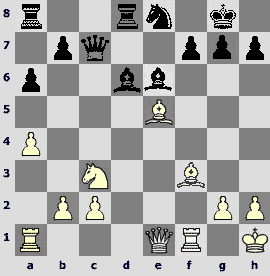
White?
The primitive 19.Ґ:d6 ¤:d6kept the equal game. However, when you play as White, you don't want to refuse from fighting for the advantage. That's why it is not surprising that Alexander Panchenko was tempted by the combination that breaks the standard material balance.
19.¤c3-d5?! Ґe6:d5!
20.Ґf3:d5 Ґd6:e5!
21.¦f1:f7 ¦d8:d5!
Black is forced to give up his queen. 21...Јc5? can be refuted by several ways. For example: 22.Ґb3 ўh8 23.Ј:e5! or 22.¦:g7+!! ў:g7 23.Ј:e5+.
22.¦f7:c7 ¤e8:c7
23.c2-c4 ¦d5-c5

Who has the advantage in this position? The material ratio is almost balanced. Perhaps, it is even better for Black. It is very important if White will be able to exploit the temporary unsteadiness of Black's pieces. If it turns out to be impossible the opponent will consolidate and catch the initiative.
24.Јe1-b4
This move suggests itself indeed. However, 24.b4!? Ґ:a1 25.bc also deserved attention. Perhaps, Evgeny Mochalov would play simply 25...Ґf6!? 26.g3 ¦e8 27.Јb4 ¦e5 keeping better chances. To my mind, the following continuation promises less 25...Ґd4 26.g3 (26.Јb4?! ¦f8 27.g3 ¦f1+ 28.ўg2 ¦f2+ 29.ўh3 ¦b2) 26...Ґ:c5 (or 26...¦e8 27.Јb4 ¤e6 28.Ј:b7 ¤:c5 29.Јd5+ ¤e6 30.Јc6) 27.Јe5 Ґb6 28.Јb2! (bad is 28.a5? ¦e8; in case of 28.Јd6 Ґa5 29.Јc5 b5 Black has the upper hand) 28...Ґa5 29.Ј:b7 and the unsuccessful arrangement of Black's pieces will not allow him to count on the advantage.
24. . . . Ґe5-d6
25.Јb4:b7 a6-a5
From the positional point of view this move is necessary indeed. However, the opponent could play either 26.Јb6!? or 26.¦f1!? That's why stronger was 25...¦f8 26.¦d1 a5 27.g3 ¦f6³.
26.¦a1-d1 ¦a8-e8
27.g2-g3
27.ўg1!?
27. . . . Ґd6-f8
28.b2-b3 ¦e8-e7

Black stands slightly better. Though the queen is the most powerful piece, Black has more active pieces. Any direct battle will be suitable for Black (for example, the attack on the opponent's king).
29.¦d1-d8?
White shouldn't weaken his rear. The correct continuation is 29.¦f1³.
29. . . . ¦c5-f5!
Worse is 29...¦f7? in view of 30.Јc8= (but not 30.¦c8? ¤e6!µ).
30.Јb7-c8 ¦e7-e1+
31.ўh1-g2 ¦e1-e2+
32.ўg2-g1 ¦e2-e1+
33.ўg1-g2 ¦e1-e2+
34.ўg2-g1 ¤c7-e6
35.c4-c5 g7-g6
35...¦fe5! wins quicker.
36.¦d8-e8 ўg8-f7
Of course, bad is 36...ўg7? 37.¦:e6 Ґ:c5+ 38.Ј:c5! ¦:c5 39.¦:e2. As it was on the previous move, 36...¦fe5! is very strong. However, the continuation that was realized in the game is also enough for the victory.
37.Јd7+ ўf6 38.¦:f8+ (the only move) 38...¤:f8 39.Јd8+ ўf7 40.Ј:a5 ¦d5! 41.ўf1 ¦c2 42.ўe1 ¦d:c5 43.Јb4 ¤e6 44.Јb7+ ¦c7 45.Јf3+ ўe7 46.Јe4 ¦:h2 47.ўd1 ¦cc2 48.Ј:c2 ¦h1+ 49.ўd2 ¦h2+ 50.ўd1 ¦:c2 51.ў:c2 ¤d4+ 52.ўd3 ¤:b3 53.ўc4 ¤d2+. White resigned.
One can't call White's combination to be incorrect but it is quite difficult to acknowledge it's right. The fact is that the material balance changed a bit in favor of Black. Moreover, he had more winning chances later on.
